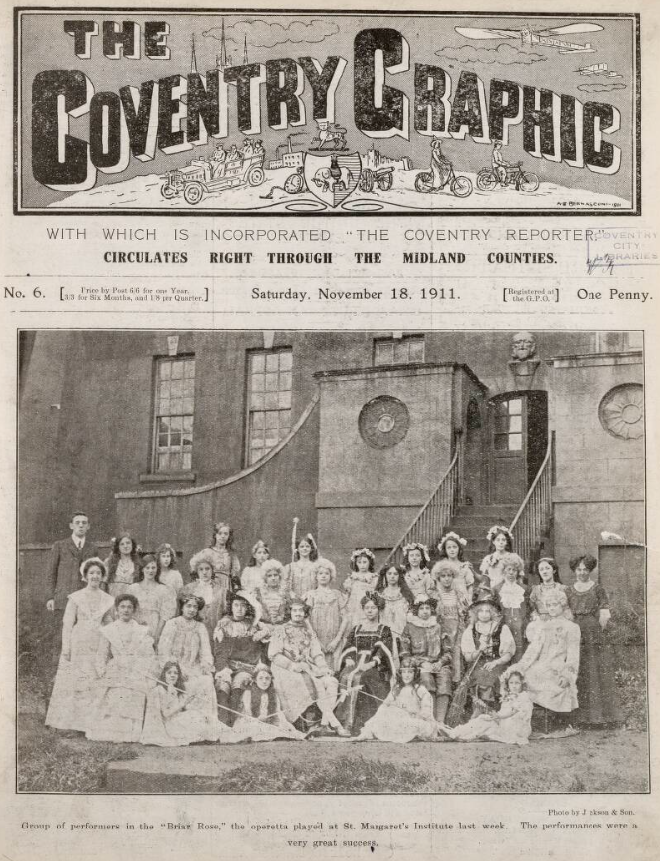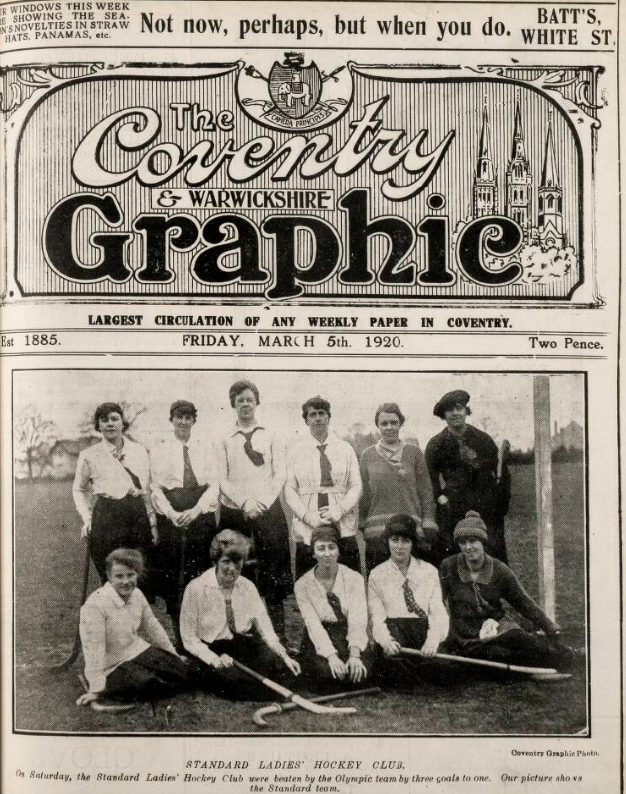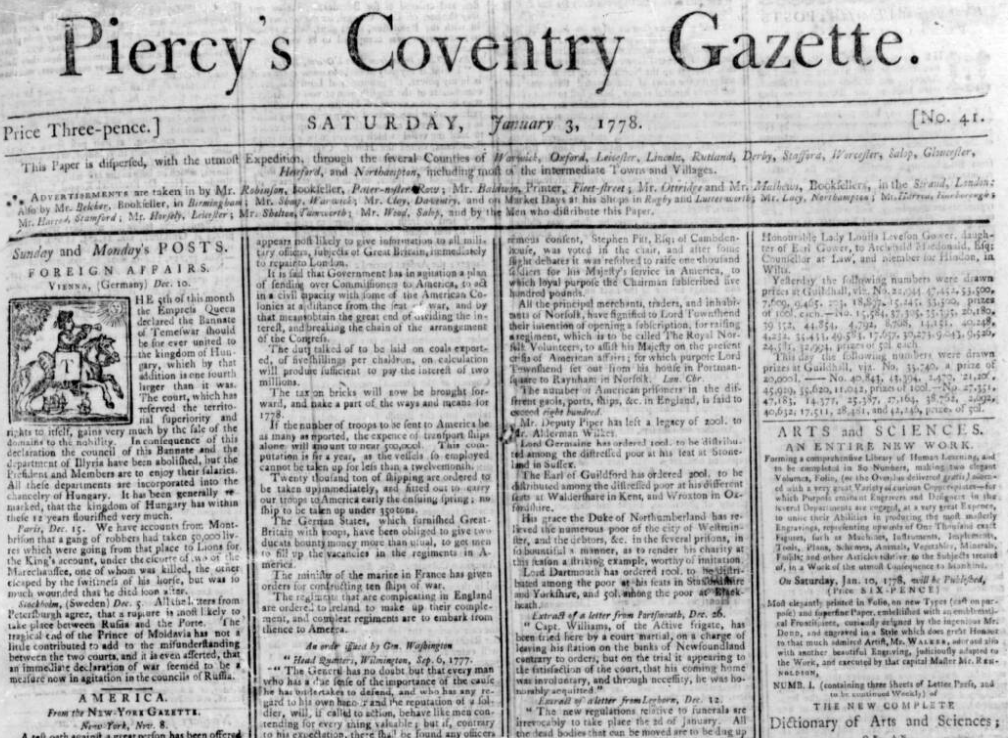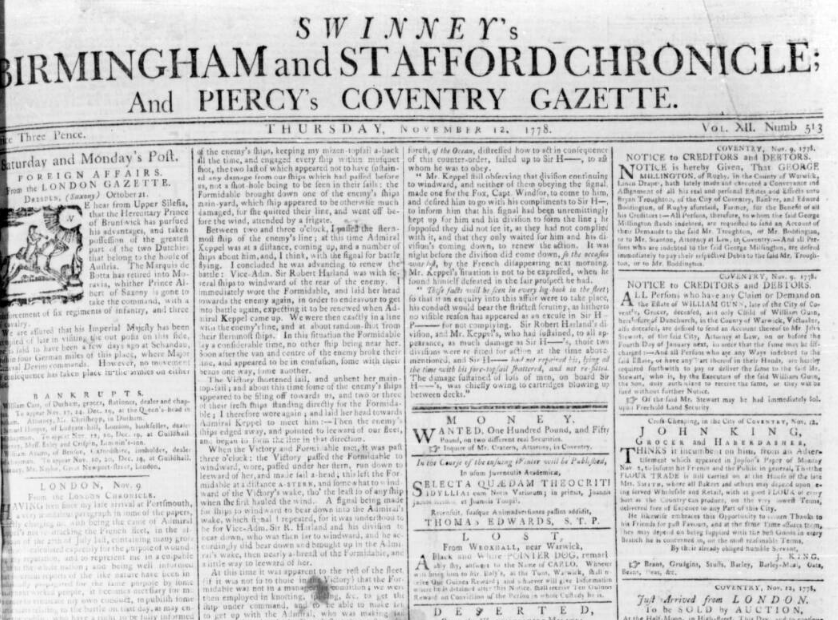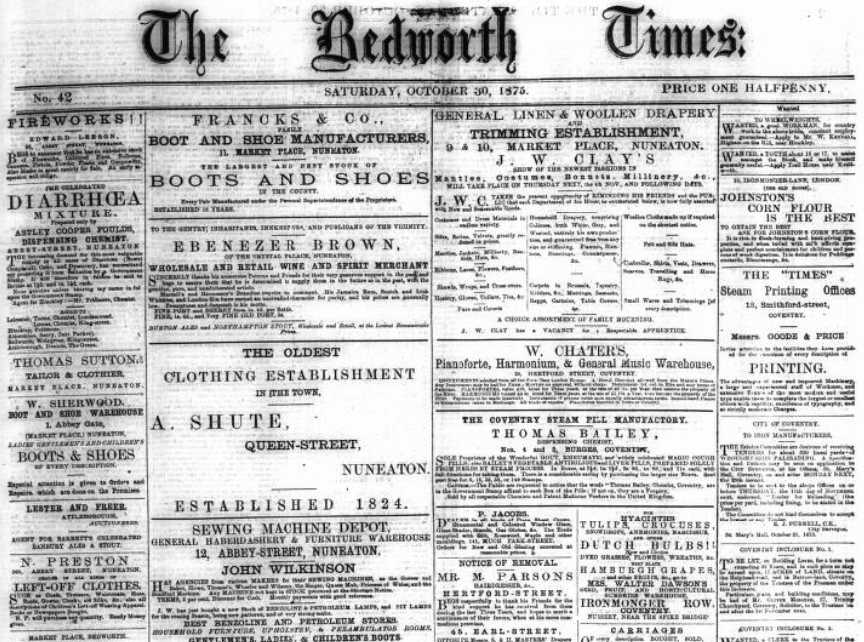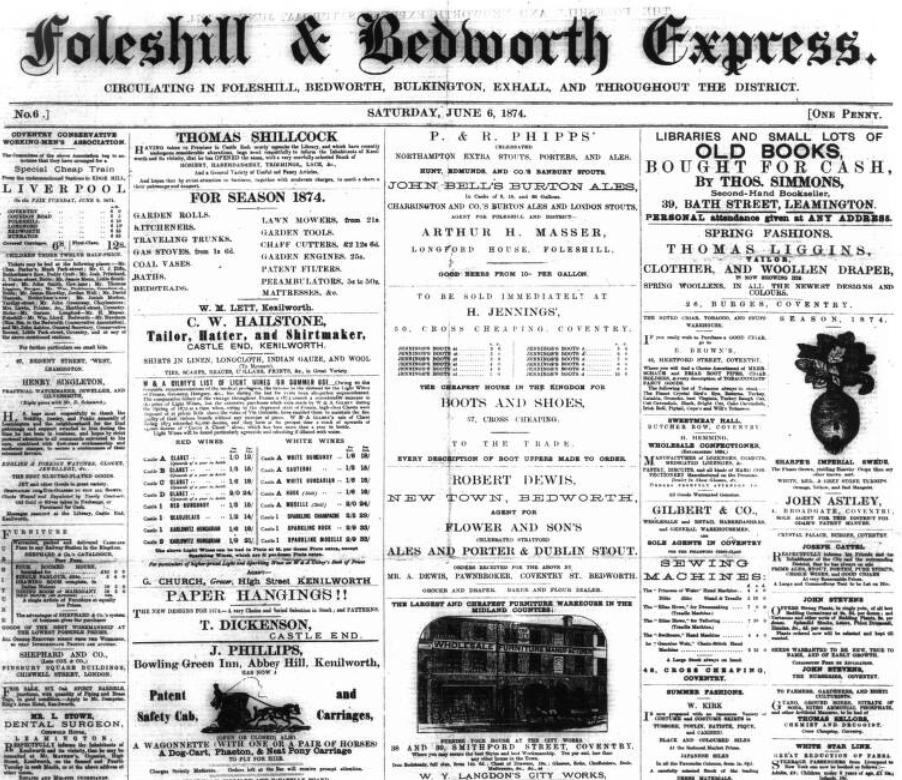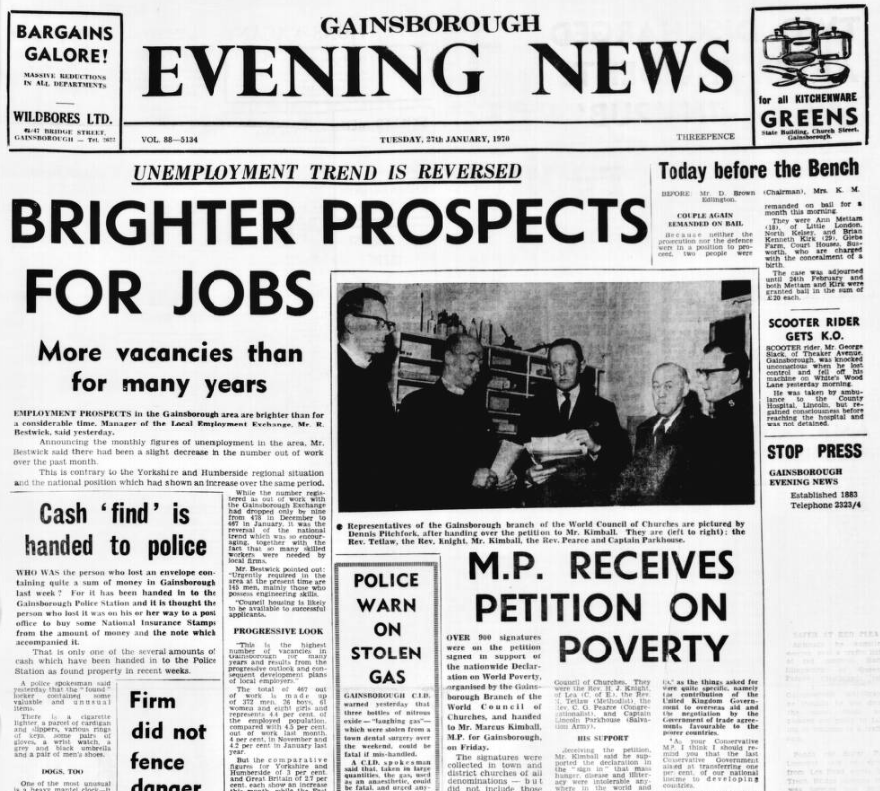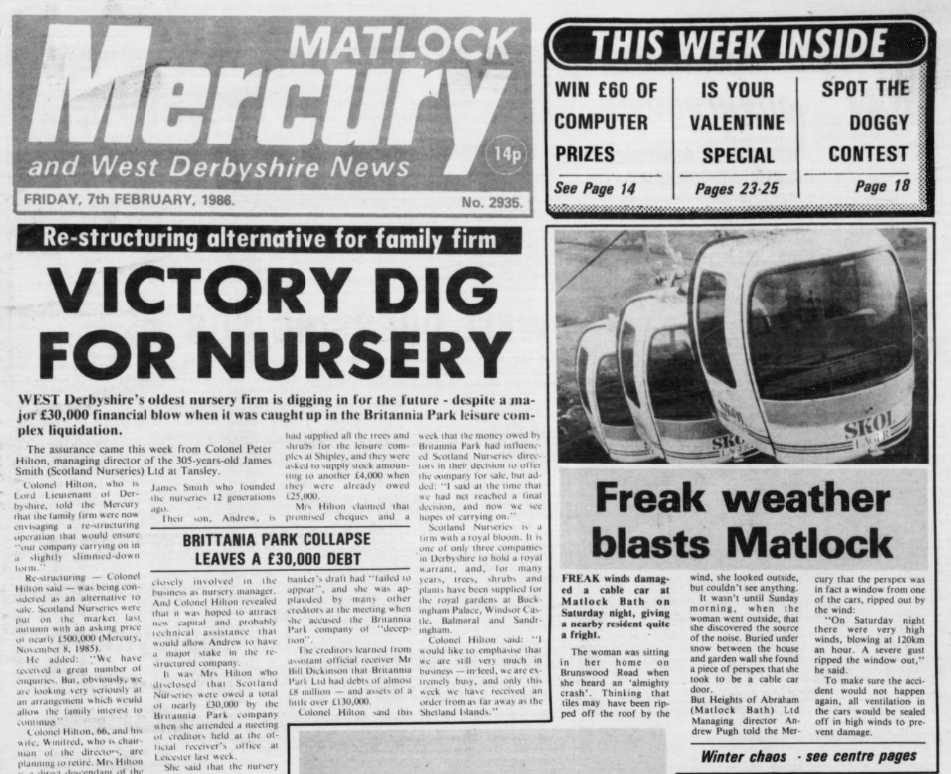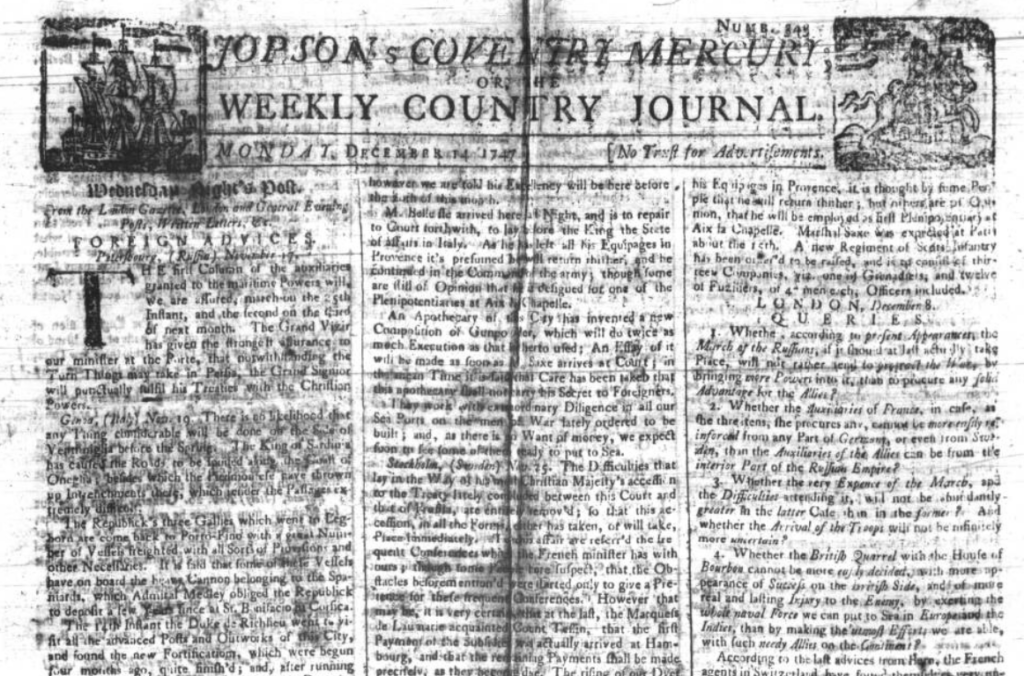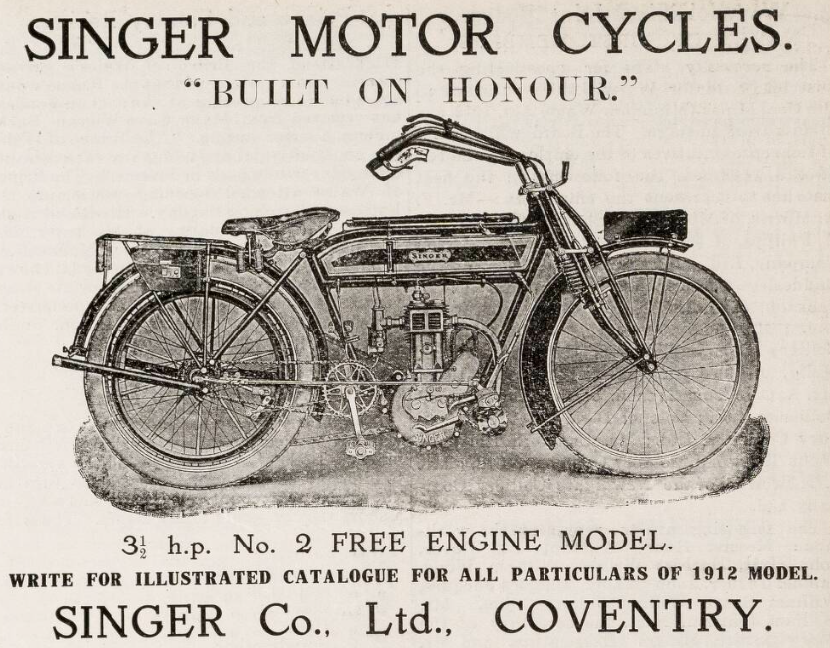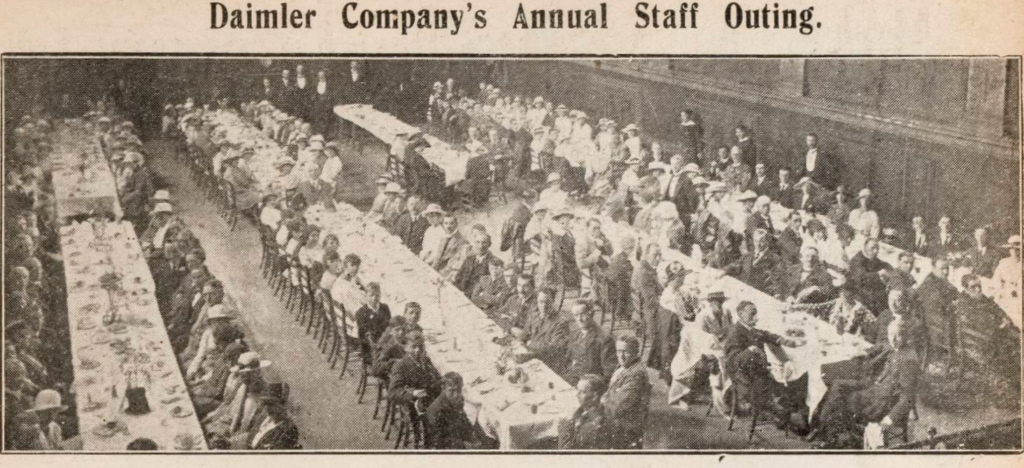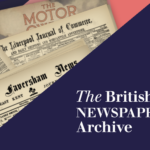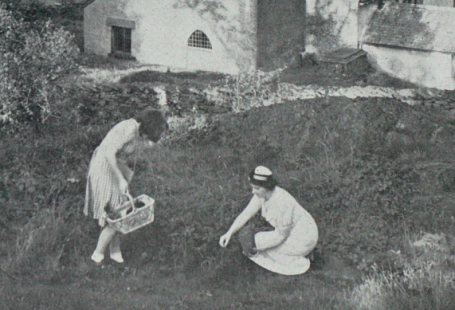This week we welcome to The Archive a host of new Coventry newspapers, alongside new titles from Derbyshire and Lincolnshire, all helping to make up 91,584 brand new pages being brought to you this week.
That’s not all, over the last seven days we’ve been updating our existing titles from across England, Scotland, and even Canada. From Eastbourne to Edinburgh, from Hartlepool to Horsham, from Morpeth to Motherwell, we’ve updated sixteen of our existing titles from our collection. Read on to discover more about these pages, as well as the six brand new newspapers we’ve added this week. Meanwhile, as we welcome our fantastic Coventry newspapers, we explore how the city’s motor industry adapted to the needs of the First World War.
Register now and explore the Archive
We start our exploration of our new Coventry newspapers this week with the Coventry Graphic, which was founded in the cathedral city of Coventry in 1911. Circulating through ‘the Midland Counties,’ this weekly newspaper appeared every Saturday and subverted contemporary newspaper norms by printing approximately 30 pages every week, with other newspapers traditionally printing between four and eight pages.
The Graphic in the Coventry newspaper title alluded to the abundance of photographs to be found within its pages. The newspaper carried photographs of local life, for example depicting members of a local Church Lads’ Brigade, alongside portraits of local personalities. We are delighted to present to you the Coventry Graphic as scanned from original paper copies, so these photographs have been preserved excellently for you to enjoy.
Costing just one penny, the Coventry Graphic was a lively read that covered local news as well as more special interest features. Reporting on ‘Police Court Gleanings,’ the Warwickshire sessions, the Coventry Opera House, and news from ‘Coventry & District,’ the paper also incorporated interesting snippets, such as a look at ‘Life on a Trawler on the Northern Seas’ and the ‘Russian Ballet,’ alongside thought-pieces such as ‘Are Athletics Healthy?’
Nothing if not entertaining, the Coventry Graphic included at least one short story as well as one serialised tale every week. The newspaper meanwhile printed a section devoted to the ‘Women’s Realm,’ a children’s column, a gardening section, a look at the ‘World of Sport,’ as well as an area devoted to ‘Cycle and Motor Notes.’
During its nearly decade of publication, it was at one time edited by Second-Lieutenant G.W. Gooch. In June 1918 the Coventry Evening Telegraph reported how the one-time editor of the fellow Coventry paper had sadly been hospitalised due to the ‘effects of gas’ whilst serving during the First World War.
The second title forming our line-up of new Coventry newspapers this week hails all the way from the eighteenth century, and it is Piercy’s Coventry Gazette. Published by J.W. Piercy, the paper has its roots in the Warwickshire Weekly Journal, which first appeared in 1769. Piercy’s newspaper, however, first appeared in March 1777 and took a radical political stance.
As Peter Borsay in his book The Eighteenth Century Town describes, newspapers across Britain at the time were taking sides over the American Revolutionary War. Rival Coventry paper Jopson’s Coventry Mercury, which is now known as the Coventry Standard and is available on The Archive for you to view, adopted a loyalist position, whilst Piercy’s Coventry Gazette adopted a radical, pro-government position.
Filling four pages, and costing three pence, Piercy’s Coventry Gazette was ‘dispersed, with the utmost Expedition, through the several Counties of Warwick, Oxford, Leicester, Lincoln, Rutland, Derby, Worcester, Salop, Gloucester, Hereford, and Northampton, including the intermediate Towns and Villages.’ Covering ‘Foreign Affairs’ alongside ‘Country News,’ Piercy’s Coventry Gazette also printed a range of adverts for books as well as the intriguingly named ‘Pullin’s Female Pills.’ However, the main focus of the paper was the American Revolutionary War.
In September 1778, as Peter Borsay relates, Piercy’s Coventry Gazette was amalgamated into Swinney’s Birmingham and Stafford Chronicle and Piercy’s Coventry Gazette. This partnership ‘incurred the wrath of the rabidly Tory Jopson’s Coventry Mercury‘ in its opposition to Lord North in the 1780 election contest, which has been described as ‘one of the most violent and corrupt of the entire century.’
The amalgamation was not to last long, however. As Joseph Hill in his survey of The Book Makers of Old Birmingham describes, Piercy’s name ‘was omitted before 1781, and shortly afterwards, Swinney and Evetts beings its printers, Coventry Gazette was also dropped.’ Indeed, the short-lived nature of Piercy’s Coventry Gazette led newspaper the Kenilworth Advertiser to observe in July 1916 that the title was ‘very short-lived – so short-lived that it finds no place in the history of local newspapers.’
The next of our new Coventry newspapers this week is the Bedworth Times, which first appeared on 16 January 1875 in the Warwickshire town of Bedworth. Bedworth is a market town situated between Coventry and Nuneaton, and when the Bedworth Times first appeared on the publishing scene, it aimed to ‘supply a weekly digest of general news.’
This new local paper was nothing if not progressive, indeed it claimed its politics to be that of ‘Progressive Liberalism,’ and this progressiveness was evidenced in its price of just one halfpenny. The newspaper’s debut editorial explained how:
The unique feature of this journal is that it is published at the unprecedently low charge of one half penny. We hope thus to put into the hands of the poorest in this locality a local paper; and undoubtedly our novel project will prove a success.
Filling four pages, the Bedworth Times appeared weekly on a Saturday. Covering the local news from the nearby towns and villages of Atherstone, Foleshill, Tamworth, Hawkesbury and Nuneaton, the paper also printed poetry, correspondence, and coverage of the markets. Enjoying only a short run, the newspaper was referenced by the Nuneaton Times on 3 July 1875, as an advert was placed for ‘fifty boys to sell the Bedworth Times.’
The fourth and final of our new Coventry newspapers this week is the Foleshill & Bedworth Express, which was published a few months before its fellow Bedworth title the Bedworth Times on 2 May 1874. ‘Circulating in Foleshill, Bedworth, Bulkington, Exhall, and Throughout The District,’ the Foleshill & Bedworth Express aimed to be a ‘strictly local paper for the extensive district of Foleshill and Bedworth,’ which consisted of some 15,000 inhabitants.
Promising to give ‘full reports…of all local and district meetings,’ the Foleshill & Bedworth Express also intended to make ‘every endeavour’ to become ‘a medium of intercommunication between the inhabitants.’ Costing one penny, and appearing every Saturday, the paper filled four pages with mainly local news, reporting on the likes of the Coventry School Board, the Coventry City Police, the County Petty Sessions, and the Coventry Board of Guardians.
Destined to be short-lived like its Coventry contemporary the Bedworth Times, the Foleshill & Bedworth Express printed sporting news alongside the latest news from parliament, as well as notices of births, marriages and deaths.
Moving on now from our trio of new Coventry newspapers, we travel to Lincolnshire to welcome the Gainsborough Evening News. The Gainsborough Evening News was founded in the Lincolnshire market town of Gainsborough in 1883. Politically independent, it appeared every Tuesday and promised to provide the weekend’s ‘news, sport and pictures.’
Indeed, it ran with the tagline of ‘Complete the Week with the Gainsborough Evening News.’ Filling eight pages, the title had a particular emphasis on sport in all its forms, in the 1950s reporting on everything from hockey to football, from darts to dominos. Costing just two pence during this decade, the newspaper also reported on local news, and printed photographs of local personalities.
From Lincolnshire now to Derbyshire, and to our final new title of the week, which is the Matlock Mercury. This title has a fascinating history, beginning life in 1931 as Coming Events, a local entertainment guide published by Ella Smith from her home on Bakewell Road, Matlock. Indeed, this would be the home of the Matlock Mercury until October 2000.
Coming Events was ‘distributed free in the district’ until 1940. A piece in the Ashbourne Telegraph in November 1953 describes how:
In 1940 it was threatened with extinction by the Control of Paper order, there being no allocation for free publications. Public support was solicited and the response was sufficient to convince the authorities that it was serving a very useful purpose. To conform to the regulations a charge of 1/6d per year was made.
Ella Smith, who was still at the helm, oversaw the publication’s transition to newspaper format, and in 1950 the name of the Matlock Mercury was adopted. Smith sold the newspaper to journalist John Uprichard in the 1970s, who alongside his wife Beryl, updated and modernised the title.
Serving Matlock, Darley Dale, Wirksworth, Bakewell and other smaller villages in the Derbyshire Dales, the Matlock Mercury is published to this day, appearing every Thursday.
That’s it from our new titles of the week, but continuing with our Coventry newspapers theme, we’ve added pages from the years 1747 through to 1831 to the historic Coventry Standard. Established in 1741 as Jopson’s Coventry Mercury, the paper has been described as ‘undoubtedly one of the best produced provincial journals of the time,’ and is published today as the Coventry Standard.
Other highlights from our updated titles this week are the over 147,000 brand new pages that we have added to the Northamptonshire Evening Telegraph, whilst over 30,000 brand new pages join the Hartlepool Northern Daily Mail. Meanwhile, we’ve crossed the pond to add the year 1881 to Canadian newspaper the Toronto Daily Mail, while new pages join four of our Scottish titles, namely the Arbroath Herald, the Edinburgh Evening News, the Motherwell Times and the Stornoway Gazette and West Coast Advertiser.
Coventry’s Motor Industry and the First World War
With the addition of our wonderful Coventry newspapers this week, we would be remiss if we didn’t mention one of things that really puts the city of Coventry on the map: its motor industry. Evolving out of its position as having the largest bicycle industry in the world, the city stepped into the production of motor manufacture. In the early twentieth century, Coventry became one of the major hubs of the British motor industry, with such manufacturers as Alvis, Daimler, Jaguar, Rover, Swift and Triumph having their roots in the city.
One of our new Coventry newspapers this week, the Coventry Graphic, provides a record of the impact of the First World War onto the city’s motor manufacturing industry.
On 11 June 1915 the Coventry Graphic reported in its regular ‘Motor and Cycle Notes‘ column on the ‘threatened famine in motor vehicles,’ relating how:
The prospect of local manufacturers turning their attention to the manufacture of shells is likely to have an extraordinary effect on the motoring public. A considerable percentage of vehicles one meets on the road, more especially light cars and motor cycles and side-cars, are of Coventry manufacture, and the complete suspension of production will have a far-reaching effect on motoring as a whole.
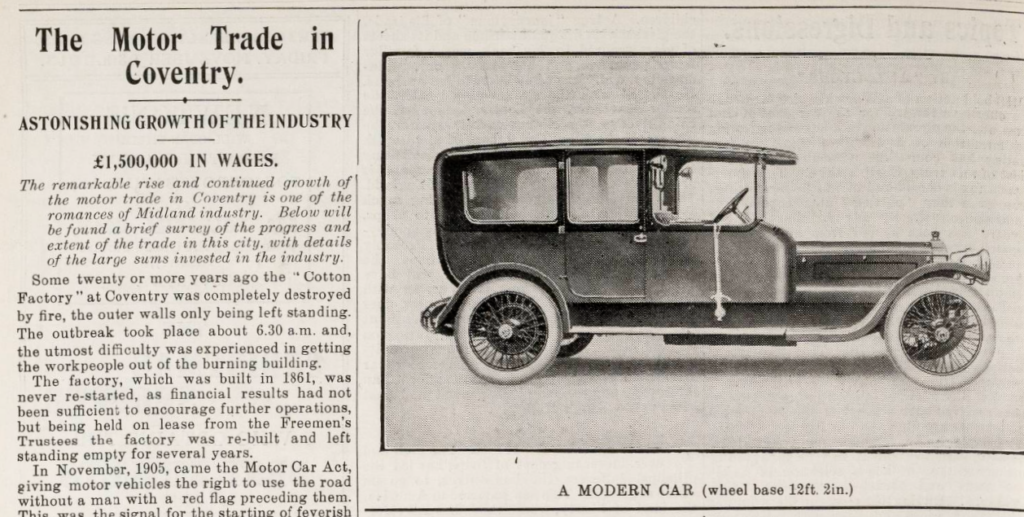
The fear expressed in this column is that as motor manufacturers in Coventry turned their attention to supporting the war effort, there would be a dearth of British made cars on the road. This may in turn lead to the ‘purchasing of foreign-made cars,’ or indeed, the death of motoring ‘for pleasure purposes.’
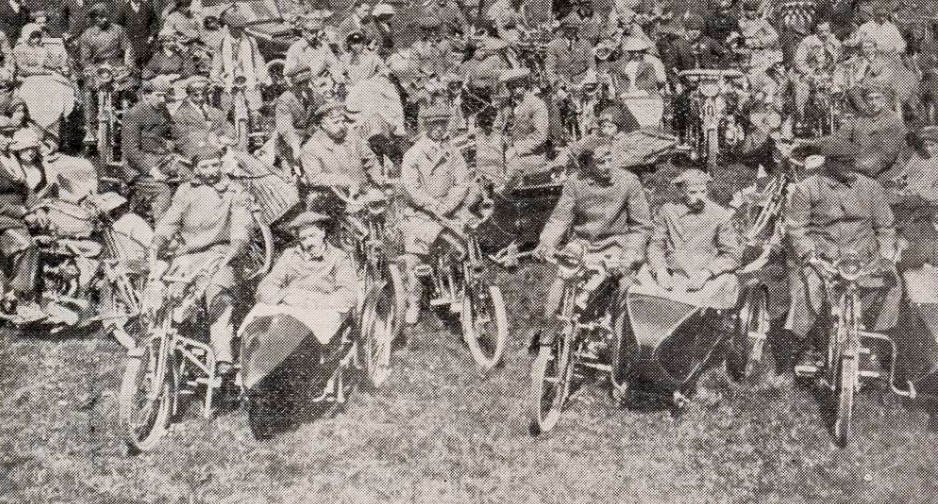
By September of 1915 the Coventry Graphic provided an update on the state of the city’s motor industry during wartime:
Coventry is undoubtedly in considerable peril…In order to make the munitions of war she has adapted holus-bolus all the wonderful mechanism that was formerly used in the manufacture of motor cars and bicycles. Big firms in Coventry have accepted contracts for war work, and, so patriotic is the city, that the lesser firms have crowded forward to help out the big ones in bustling through the work. The obvious result is that – except for the building of motor ambulances – the staple trade of the city is at a standstill…and Coventry has so adapted herself as to be a city of munitions and supplies workers.
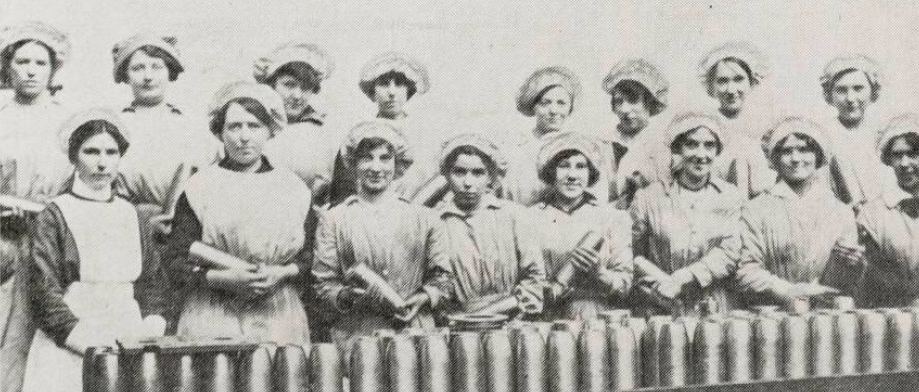
The piece continued:
If at the end of all that she finds herself crippled in her staple industry it will be hard luck indeed. In fact, all this economy and thrift, which is so essential to the poor man, should be brought home in equal measure to the rich, and people ought not buy motor cars at all except for military use, especially cars made outside British Dominions. Coventry must not be allowed to suffer when peace comes.
However, as an article entitled ‘What Motor Makers Have Done For The War‘ for the Coventry Graphic a few years later on 16 February 1917 outlined, these fears were unfounded. As war broke out, ‘existing stocks of all classes of motor vehicles were commandeered by the authorities for military use,’ while new cars, altered for military purposes, ‘were built more numerously and more rapidly than in the ordinary course of events.’
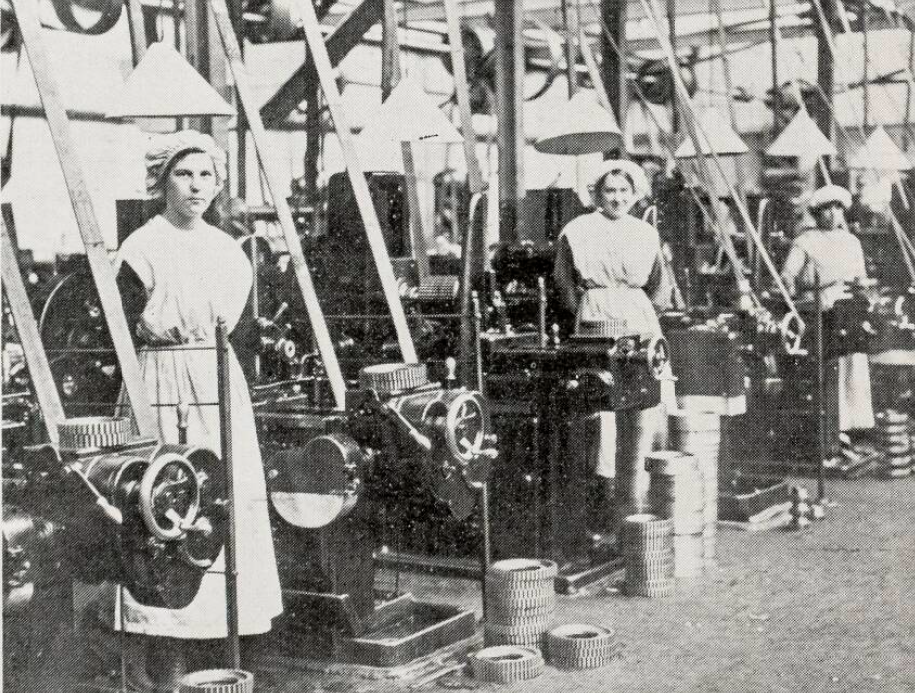
The impact on Coventry was a positive one, as the piece described:
Coventry, the throbbing heart of the motor industry, had become busier than ever. Its factories and works were turning out more cars and components than ever before in its history. Skilled workmen were being brought in by the hundred every day from neighbouring towns like Birmingham, Leamington, and Warwick, because Coventry could not provide accommodate for them all. The output had been enormous.
Indeed, the impact of the First World War on Coventry’s industry was transformative. Workers flooded to the city’s booming factories. Indeed, Coventry’s importance as one of Britain’s key industrial hubs would make it a target for Luftwaffe air raids in the Second World War, the city suffering devastating bomb damage as a result.
Find out more about Coventry, the history of Britain’s motor industry, and much more besides, in the pages of our newspaper Archive today.
New Titles
| Title | Years Added |
| Bedworth Times | 1875-1876 |
| Coventry Graphic | 1912-1921 |
| Foleshill & Bedworth Express | 1874-1876 |
| Gainsborough Evening News | 1954-1983, 1987, 1992-1994, 1996 |
| Matlock Mercury | 1986-1988, 1990, 1992-1994, 1996, 1998, 2000 |
| Piercy’s Coventry Gazette | 1778 |
Updated Titles
This week we have updated sixteen of our existing titles.
You can learn more about each of the titles we add to every week by clicking on their names. On each paper’s title page, you can read a FREE sample issue, learn more about our current holdings, and our plans for digitisation.
| Title | Years Added |
| Arbroath Herald | 1964-1973 |
| Coventry Standard | 1747-1748, 1751, 1755, 1757, 1759-1794, 1798-1811, 1814-1831 |
| Derbyshire Times | 1986 |
| Eastbourne Gazette | 1988 |
| Edinburgh Evening News | 1995 |
| Hartlepool Northern Daily Mail | 1982, 1985-1987 |
| Leamington Spa Courier | 1984, 1987 |
| Market Harborough Advertiser and Midland Mail | 1993, 1995-1996, 1998 |
| Melton Mowbray Times and Vale of Belvoir Gazette | 1890-1893, 1999 |
| Morpeth Herald | 1998-1999 |
| Motherwell Times | 1983 |
| Northamptonshire Evening Telegraph | 1955-1956, 1987-1988, 1990-1991, 1993-1995, 1997-1998, 2001 |
| Rugby Advertiser | 1855, 1960-1968, 1984 |
| Stornoway Gazette and West Coast Advertiser | 1967-1971, 1975-1985, 1988 |
| Toronto Daily Mail | 1881 |
| West Sussex County Times | 1983, 1986-1987 |
You can keep up to date with all the latest additions by visiting the recently added page. You can even look ahead to see what we’re going to add tomorrow.


